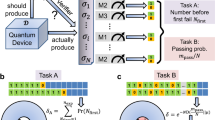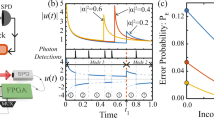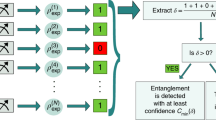Abstract
The most common form of measurement in quantum mechanics projects a wavefunction onto orthogonal states that correspond to definite outcomes. However, generalized quantum measurements that do not fully project quantum states are possible and have an important role in quantum information tasks. Unfortunately, it is difficult to certify that an experiment harvests the advantages made possible by generalized measurements, especially beyond the simplest two-level qubit system. Here we show that multiport beamsplitters allow for the robust realization of high-quality generalized measurements in higher-dimensional systems with more than two levels. Using multicore optical fibre technology, we implement a seven-outcome generalized measurement in a four-dimensional Hilbert space with a fidelity of 99.7%. We present a practical quantum communication task and demonstrate a success rate that cannot be simulated in any conceivable quantum protocol based on standard projective measurements on quantum messages of the same dimension. Our approach, which is compatible with modern photonic platforms, showcases an avenue for faithful and high-quality implementation of genuinely non-projective quantum measurements beyond qubit systems.
This is a preview of subscription content, access via your institution
Access options
Access Nature and 54 other Nature Portfolio journals
Get Nature+, our best-value online-access subscription
$29.99 / 30 days
cancel any time
Subscribe to this journal
Receive 12 print issues and online access
$209.00 per year
only $17.42 per issue
Buy this article
- Purchase on Springer Link
- Instant access to full article PDF
Prices may be subject to local taxes which are calculated during checkout





Similar content being viewed by others
Data availability
Source data are provided with this paper. Any additional data related to the findings of this paper are available upon reasonable request.
Code availability
Computer codes related to the findings of this paper are available upon request.
References
Neumann, J. V. Mathematical Foundations of Quantum Mechanics New edition (Princeton Univ. Press, 2018).
Nielsen, M. A. and Chuang, I. L. Quantum Computation and Quantum Information 10th Anniversary edition (Cambridge Univ. Press, 2011).
D'Ariano, G. M., Presti, P. L. & Perinotti, P. Classical randomness in quantum measurements. J. Phys. A: Math. Gen. 38, 5979 (2005).
Barnett, S. M. & Croke, S. Quantum state discrimination. Adv. Opt. Photon. 1, 238 (2009).
Derka, R., Buzek, V. & Ekert, A. K. Universal algorithm for optimal estimation of quantum states from finite ensembles via realizable generalized measurement. Phys. Rev. Lett. 80, 1571 (1998).
Bennett, C. H. Quantum cryptography using any two nonorthogonal states. Phys. Rev. Lett. 68, 3121 (1992).
Englert, B.-G. et al. Efficient and robust quantum key distribution with minimal state tomography. Preprint at https://arxiv.org/abs/quant-ph/0412075v4 (2004).
Acín, A., Pironio, S., Vértesi, T. & Wittek, P. Optimal randomness certification from one entangled bit. Phys. Rev. A 93, 040102 (2016).
Tavakoli, A., Farkas, M., Rosset, D., Bancal, J.-D. & Kaniewski, J. Mutually unbiased bases and symmetric informationally complete measurements in bell experiments. Sci. Adv. 7, eabc3847 (2021).
Shang, J., Asadian, A., Zhu, H. & Gühne, O. Enhanced entanglement criterion via symmetric informationally complete measurements. Phys. Rev. A 98, 022309 (2018).
Bae, J., Hiesmayr, B. C. & McNulty, D. Linking entanglement detection and state tomography via quantum 2-designs. New J. Phys. 21, 013012 (2019).
Tavakoli, A., Smania, M., Vértesi, T., Brunner, N. & Bourennane, M. Self-testing nonprojective quantum measurements in prepare-and-measure experiments. Sci. Adv. 6, eaaw6664 (2020).
Clarke, R. B. M., Chefles, A., Barnett, S. M. & Riis, E. Experimental demonstration of optimal unambiguous state discrimination. Phys. Rev. A 63, 040305 (2001).
Mosley, P. J., Croke, S., Walmsley, I. A. & Barnett, S. M. Experimental realization of maximum confidence quantum state discrimination for the extraction of quantum information. Phys. Rev. Lett. 97, 193601 (2006).
Du, J., Sun, M., Peng, X. & Durt, T. Realization of entanglement-assisted qubit-covariant symmetric-informationally-complete positive-operator-valued measurements. Phys. Rev. A 74, 042341 (2006).
Durt, T., Kurtsiefer, C., Lamas-Linares, A. & Ling, A. Wigner tomography of two-qubit states and quantum cryptography. Phys. Rev. A 78, 042338 (2008).
Medendorp, Z. E. D. et al. Experimental characterization of qutrits using symmetric informationally complete positive operator-valued measurements. Phys. Rev. A 83, 051801 (2011).
Waldherr, G. et al. Distinguishing between nonorthogonal quantum states of a single nuclear spin. Phys. Rev. Lett. 109, 180501 (2012).
Pimenta, W. M. et al. Minimum tomography of two entangled qutrits using local measurements of one-qutrit symmetric informationally complete positive operator-valued measure. Phys. Rev. A 88, 012112 (2013).
Agnew, M., Bolduc, E., Resch, K. J., Franke-Arnold, S. & Leach, J. Discriminating single-photon states unambiguously in high dimensions. Phys. Rev. Lett. 113, 020501 (2014).
Zhao, Y.-y et al. Experimental realization of generalized qubit measurements based on quantum walks. Phys. Rev. A 91, 042101 (2015).
Bent, N. et al. Experimental realization of quantum tomography of photonic qudits via symmetric informationally complete positive operator-valued measures. Phys. Rev. X 5, 041006 (2015).
Bian, Z. et al. Realization of single-qubit positive-operator-valued measurement via a one-dimensional photonic quantum walk. Phys. Rev. Lett. 114, 203602 (2015).
Schiavon, M., Vallone, G. & Villoresi, P. Experimental realization of equiangular three-state quantum key distribution. Sci. Rep. 6, 30089 (2016).
Sosa-Martinez, H. et al. Experimental study of optimal measurements for quantum state tomography. Phys. Rev. Lett. 119, 150401 (2017).
Bouchard, F. et al. Experimental investigation of high-dimensional quantum key distribution protocols with twisted photons. Quantum 2, 111 (2018).
Cai, W. et al. High-efficiency arbitrary quantum operation on a high-dimensional quantum system. Phys. Rev. Lett. 127, 090504 (2021).
Tabia, G. N. M. Experimental scheme for qubit and qutrit symmetric informationally complete positive operator-valued measurements using multiport devices. Phys. Rev. A 86, 062107 (2012).
Gómez, E. S. et al. Device-independent certification of a nonprojective qubit measurement. Phys. Rev. Lett. 117, 260401 (2016).
Gómez, S. et al. Experimental nonlocality-based randomness generation with nonprojective measurements. Phys. Rev. A 97, 040102 (2018).
Smania, M. et al. Experimental certification of an informationally complete quantum measurement in a device-independent protocol. Optica 7, 123 (2020).
Erhard, M., Fickler, R., Krenn, M. & Zeilinger, A. Twisted photons: new quantum perspectives in high dimensions. Light.: Sci. Appl. 7, 17146 (2018).
Erhard, M., Krenn, M. & Zeilinger, A. Advances in high-dimensional quantum entanglement. Nat. Rev. Phys. 2, 365 (2020).
Tavakoli, A., Kaniewski, Jmk, Vértesi, T., Rosset, D. & Brunner, N. Self-testing quantum states and measurements in the prepare-and-measure scenario. Phys. Rev. A 98, 062307 (2018).
Tavakoli, A., Rosset, D. & Renou, M.-O. Enabling computation of correlation bounds for finite-dimensional quantum systems via symmetrization. Phys. Rev. Lett. 122, 070501 (2019).
Gan, L. et al. Spatial-division multiplexed mach-zehnder interferometers in heterogeneous multicore fiber for multiparameter measurement. IEEE Photon. J. 8, 1 (2016).
Cariñe, J. et al. Multi-core fiber integrated multi-port beam splitters for quantum information processing. Optica 7, 542 (2020).
Richardson, D. J., Fini, J. M. & Nelson, L. E. Space-division multiplexing in optical fibres. Nat. Photon. 7, 354 (2013).
Ding, Y. et al. High-dimensional quantum key distribution based on multicore fiber using silicon photonic integrated circuits. npj Quantum Inf. 3, 25 (2017).
Politi, A., Cryan, M. J., Rarity, J. G., Yu, S. & O’Brien, J. L. Silica-on-silicon waveguide quantum circuits. Science 320, 646 (2008).
Carolan, J. et al. Universal linear optics. Science 349, 711 (2015).
Spagnolo, N. et al. Three-photon bosonic coalescence in an integrated tritter. Nat. Commun. 4, 1606 (2013).
Wang, J. et al. Multidimensional quantum entanglement with large-scale integrated optics. Science 360, 285 (2018).
Chen, P.-X., Bergou, J. A., Zhu, S.-Y. & Guo, G.-C. Ancilla dimensions needed to carry out positive-operator-valued measurement. Phys. Rev. A 76, 060303 (2007).
Navascués, M. & Vértesi, T. Bounding the set of finite dimensional quantum correlations. Phys. Rev. Lett. 115, 020501 (2015).
Xavier, G. B. & Lima, G. Quantum information processing with space-division multiplexing optical fibres. Commun. Phys. 3, 9 (2020).
Lee, H. J., Choi, S.-K. & Park, H. S. Experimental demonstration of four-dimensional photonic spatial entanglement between multi-core optical fibres. Sci. Rep. 7, 4302 (2017).
Lee, H. J. & Park, H. S. Generation and measurement of arbitrary four-dimensional spatial entanglement between photons in multicore fibers. Photon. Res. 7, 19 (2019).
Farkas, M., Guerrero, N., Cariñe, J., Cañas, G. & Lima, G. Self-testing mutually unbiased bases in higher dimensions with space-division multiplexing optical fiber technology. Phys. Rev. Appl. 15, 014028 (2021).
Gómez, E. S. et al. Multidimensional entanglement generation with multicore optical fibers. Phys. Rev. Appl. 15, 034024 (2021).
Cañas, G. et al. High-dimensional decoy-state quantum key distribution over multicore telecommunication fibers. Phys. Rev. A 96, 022317 (2017).
Da Lio, B. et al. Stable transmission of high-dimensional quantum states over a 2-km multicore fiber. IEEE J. Sel. Top. Quantum Electron. 26, 1 (2020).
Da Lio, B. et al. Path-encoded high-dimensional quantum communication over a 2-km multicore fiber. npj Quantum Inf. 7, 63 (2021).
Taddei, M. M. et al. Computational advantage from the quantum superposition of multiple temporal orders of photonic gates. PRX Quantum 2, 010320 (2021).
Gisin, N., Ribordy, G., Tittel, W. & Zbinden, H. Quantum cryptography. Rev. Mod. Phys. 74, 145 (2002).
Watanabe, K., Saito, T., Imamura, K. & Shiino, M. Development of fiber bundle type fan-out for multicore fiber. In 2012 17th Opto-Electronics and Communications Conference 475-476 (IEEE, 2012). https://doi.org/10.1109/OECC.2012.6276529
Navascués, M., Feix, A., Araújo, M. & Vértesi, T. Characterizing finite-dimensional quantum behavior. Phys. Rev. A 92, 042117 (2015).
Bhatnagar, P. & Nema, R. Maximum power point tracking control techniques: state-of-the-art in photovoltaic applications. Renew. Sustain. Energy Rev. 23, 224 (2013).
Acknowledgements
This work was supported by ANID – Fondo Nacional de Desarrollo Científico y Tecnológico (FONDECYT) (grant nos. 11201348, 1180558, 1190901, 1200266, 1200859 and 3200779) and ANID – Millennium Science Initiative Program ICN17_012. J.C. acknowledges financial support from ANID/REC/PAI77190088. L.P. was supported by ANID-PFCHA/DOCTORADO-BECAS-CHILE/2019-72200275, the Spanish Project No. PGC2018-094792-B-I00 (MCIU/AEI/FEDER, UE) and CAM/FEDER Project No. S2018/TCS-4342 (QUITEMAD-CM). A.T. is supported by the Wenner-Gren Foundation.
Author information
Authors and Affiliations
Contributions
D.M., E.S.G. and J.C. performed the experiment and analyzed the data under the supervision of S.P.W. and G.L. A.D. and L.P. theoretically modelled the quantum device. A.T. developed the theory of the protocol. All authors contributed to the writing of the manuscript.
Corresponding author
Ethics declarations
Competing interests
The authors declare no competing interests.
Peer review
Peer review information
Nature Physics thanks the anonymous reviewers for their contribution to the peer review of this work
Additional information
Publisher’s note Springer Nature remains neutral with regard to jurisdictional claims in published maps and institutional affiliations.
Supplementary information
Supplementary Information
Supplementary Sections I, II and III.
Source data
Source Data Fig. 1
Experimental raw data.
Rights and permissions
Springer Nature or its licensor (e.g. a society or other partner) holds exclusive rights to this article under a publishing agreement with the author(s) or other rightsholder(s); author self-archiving of the accepted manuscript version of this article is solely governed by the terms of such publishing agreement and applicable law.
About this article
Cite this article
Martínez, D., Gómez, E.S., Cariñe, J. et al. Certification of a non-projective qudit measurement using multiport beamsplitters. Nat. Phys. 19, 190–195 (2023). https://doi.org/10.1038/s41567-022-01845-z
Received:
Accepted:
Published:
Issue Date:
DOI: https://doi.org/10.1038/s41567-022-01845-z
This article is cited by
-
Integrated multi-mode waveguide devices for quantum communication
Journal of Optics (2023)



